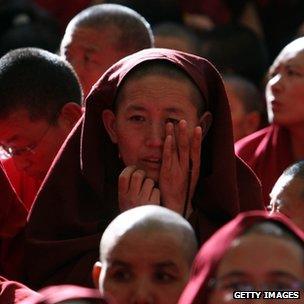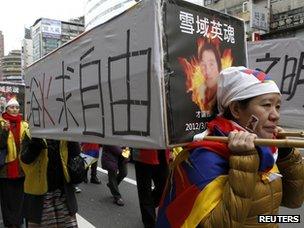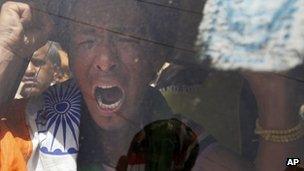Self-immolations shake Tibetan resolve
- Published
A series of self-immolations in protest against Chinese rule has shaken exiled Tibetans' faith in their spiritual leader and the path of non-violence.
At 76, the Dalai Lama has announced his retirement as a political leader, but retains his role as spiritual leader of some five million Tibetans.
But he has remained strangely quiet on the subject of the self-immolations - 32 of which have taken place in the past year alone.
"Now this is very, very sensitive political issue," he explains with due solemnity.

Exiled Tibetan monks are growing frustrated with the Dalai Lama's handling of self-immolations
"If I get involved in that, then the retirement from political power is meaningless. Whatever I say the Chinese government they immediately manipulate."
For more than 50 years now, the Dalai Lama has been pursuing his "middle way" - a policy of advocating non-violence while pursuing a programme of talks between successive Chinese governments and his representatives.
But, he admits, it has been a waste of time. There have been no talks for more than two years.
"Our approach [has been] more or less failure to get some kind of cross understanding with the Chinese government and some kind of improvement inside Tibet. In that aspect [it has] completely failed," he says.
"These [Chinese] leaders are very foolish, narrow minded, authoritarian sort of people," he says.
"They use only their mouth. No ear, never willing to listen to others. As far as their government is concerned, they are really very, very hardened.
"They do not understand what is the real Tibetan feeling."
He speaks with emphasis and anger. It is the most ungodlike behaviour I have ever witnessed from His Holiness, the 14th Dalai Lama, in 20 years of interviewing him.
He is fed up and so are his followers. But for decades, it was considered almost blasphemy to criticise the Dalai Lama and his policies. Not any more.
"I question the current policy and position of His Holiness not to face reality and then forcing Tibetans to commit suicide," says 60-year-old Lhasang Tsering, a former president of the influential Tibetan Youth Congress.
Karma Chophel, a former speaker of the Tibetan parliament in exile, takes the warning further.
"Non-violence has not worked. Violence could now be the only option," he says.
Disparate acts
There have been 32 self-immolations among mainly monks and nuns living in the Tibetan areas of China over the past year alone.
Norbu, a Tibetan from Sichuan province in China, braved the perilous journey over the Himalayas to find refuge in India.
"I had to come," he says, "to tell the world what is happening."
"I was shopping in Ngaba [Aba] town when suddenly two monks ran down the street in flames. One was holding a Tibetan flag and shouting for freedom of religion and for the return of the Dalai Lama.
"After a few minutes, police, firemen and soldiers arrived, put out the flames and threw the two monks in to the back of an army truck. We were told they were being treated in hospital but no one has been allowed to visit them and so we don't know whether they are dead or alive."
The self-immolations witnessed by Norbu took place in September last year. Lobsang Kalsang and Lobsang Kunchok were both 18 years old.
Nearly all of these desperate acts follow the same pattern. The monks and nuns (there have been only two civilians) drink kerosene and splash it over their bodies before setting themselves alight.
Many wrap themselves in barbed wire to make it harder for the police to stop them. All policemen in the area carry fire extinguishers.

There have been 32 self-immolations in the past year
If Norbu was so anxious to tell his story, I ask, why did it take him so long to leave Sichuan province?
He explains that there are now three military camps surrounding Kirti monastery, where the majority of those who have self-immolated come from, and "security forces and plainclothes police are everywhere. There are checkpoints on every road."
"The internet cafes have all been closed and even the public telephone office. It's as if we Tibetans have been shut up in a room and the Chinese have locked the door."
The Chinese have forbidden access to the area to outsiders. They believe they are bringing development and modernisation to backward Tibetan areas and blame outside forces - particularly the Dalai Lama - for stirring up trouble.
The only way of finding out what is going on is to watch the horrific YouTube videos of the self-immolations which are regularly posted on Tibetan support websites such as Free Tibet and the International Campaign for Tibet.
Journalists wanting to find out more head to Dharmamsala in India, where the 150,000 Tibetans living in exile with the Dalai Lama monitor the grim events taking place in their erstwhile home.
All the major monasteries in Tibet have equivalents in India. At Dharamsala's Kirti Monastery, I am directed to two monks, Kanyag Tsering and Lobsang Yishe.
While the monastery resounds to the sound of mediaeval prayersong, accompanied by cymbals, bells and giant Tibetan horns, Tsering and Yishe are on their Apple Macs and smart phones.
As I arrive in their cell at the top of the monastery, there's been another self immolation and they are hard at work.
"His name is Lobsang Tsultrim and he's 19 years old," Tsering, with his phone to his ear talking to a monk in Kirti Monastery in China, says to Yishe who is typing fast on his keyboard.
"Did he shout any slogans? What happened?"
They are told the police threw his body into a truck - he was still raising his hand and shouting "Free Tibet!"
"He's not dead yet? You're checking?" He died the next day.
Once they hear from three different sources, they send the news to Tibet support groups and journalists.

Tibetans in exile are desparate for a shift in the Chinese policy towards Tibet
The two monks then make their way up and along the narrow staircases and corridors of the monastery to the office of the head of the monastery, Kirte Rinpoche, who is also spiritual head of the monastery in China. His face contorts with pain as he hears the news.
"The recent self-immolations express the suffering not just of the monks but of the entire Tibetan people," he says.
It was Chairman Mao who once said "when there is repression the people will revolt".
In an office in Dharamsala, the current general secretary of the Tibetan Youth Congress, Tenzin Chokey, is sitting at her computer monitoring the pictures coming in from Tibet.
They show demonstrations involving thousands of Tibetans as news of the latest self-immolation spreads through Ngaba [Aba] county in Sichuan province.
"Listen," she says as she leans forward towards the screen to try and hear what the crowds are saying, "people in Tibet have spoken and they want freedom and independence. We're scared. Up until now, it has been non-violent. But it could spiral out of control."
That evening, news of another self-immolation reaches Dharamsala. Monks, nuns and lay people take to the streets for a candlelit procession.
It used to be the Dalai Lama and his team in exile who debated the direction in which his people should go.
Now, Tibetans in Tibet are asserting themselves and those in exile can only respond with candles and prayer.
Watch Sue Lloyd-Roberts full report on Tibet on Newsnight on Wednesday 18 April 2012 at 10.30pm on BBC Two, then afterwards on the BBC iPlayer and Newsnight website.
- Published14 November 2011
- Published7 November 2011
- Published3 November 2011
- Published3 November 2011
- Published4 October 2011
- Published15 August 2011